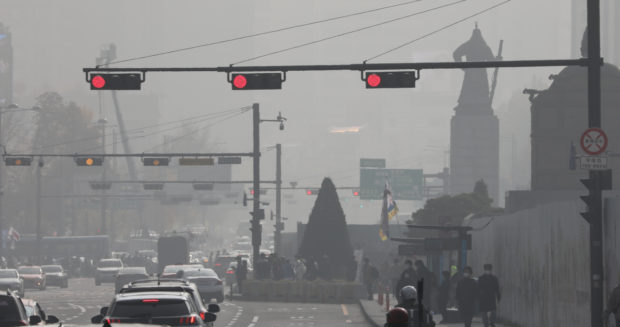Fine dust blankets much of South Korea

A road around Gwanghwamun Square in Seoul, is shrouded in fine dust on Saturday. Photo by Yonhap via The Korea Herald/Asia News Network
SEOUL — A choking pall of fine dust plagued much of South Korea on Saturday, prompting authorities to urge vulnerable people to stay indoors.
As of noon, the density of ultrafine dust, called PM 2.5, hit the “very bad” level for Seoul, Incheon, Gyeonggi Province and South Chungcheong Province, according to data from the state-run Korea Environment Corp.
Other parts of the country, excluding Gwangju and South Jeolla Province in the southwest, registered “bad.”
READ: Could bad air worsen coronavirus crisis?
The level of fine dust, called PM 10, remained “bad” for Seoul, Gyeonggi, and central and northeastern regions, while the reading elsewhere was “average.”
Article continues after this advertisementPM 2.5 and PM 10 refer to particulate matters smaller than 2.5 micrometers and 10 micrometers in diameter, respectively.
Article continues after this advertisementThe nation measures fine dust air pollution in a four-tier system — “good,” “average,” “bad” and “very bad.”
The high concentration is attributable to the combination of micro particles from China, which began to blow in Thursday night, and domestic air pollutants accumulated due to stagnant air, the state-run National Institute of Environmental Research said.
On late Friday, fine dust and ultrafine dust advisories were issued for Seoul and Gyeonggi for the first time in about six months.
Other affected parts of the country were also put under fine dust advisories Saturday.
An ultrafine dust advisory is issued when the concentration of PM 2.5 exceeds 75 micrograms per cubic meter for two hours. A fine dust advisory is issued when the concentration of PM 10 stays above 150 micrograms per cubic meter for two hours.
Micro-dust air pollution is expected to remain high for central, northeastern and southwestern regions through Sunday afternoon, the institute said, before it begins to ease with rain and strong winds expected Sunday night. (Yonhap)